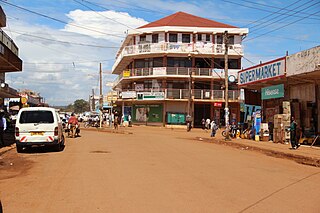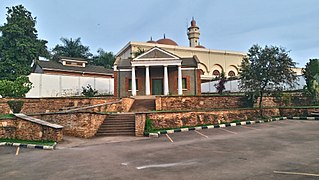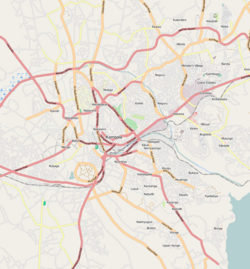
Tripoli is the capital and largest city of Libya, with a population of about 1.183 million people in 2023. It is located in the northwest of Libya on the edge of the desert, on a point of rocky land projecting into the Mediterranean Sea and forming a bay. It includes the port of Tripoli and the country's largest commercial and manufacturing center. It is also the site of the University of Tripoli.

Kampala is the capital and largest city of Uganda. The city proper has a population of 1,680,600 (2020) and is divided into the five political divisions of Kampala Central Division, Kawempe Division, Makindye Division, Nakawa Division, and Rubaga Division.

Idi Amin Dada Oumee was a Ugandan military officer and politician who served as the third president of Uganda from 1971 to 1979. He ruled as a military dictator and is considered one of the most brutal despots in modern world history.

The Second Republic of Uganda existed from 1971 to 1979, when Uganda was ruled by Idi Amin's military dictatorship.

Jinja is a city in the Eastern Region of Uganda, located on the north shore of Lake Victoria.

The Uganda–Tanzania War, known in Tanzania as the Kagera War and in Uganda as the 1979 Liberation War, was fought between Uganda and Tanzania from October 1978 until June 1979 and led to the overthrow of Ugandan President Idi Amin. The war was preceded by a deterioration of relations between Uganda and Tanzania following Amin's 1971 overthrow of President Milton Obote, who was close to the President of Tanzania, Julius Nyerere. Over the following years, Amin's regime was destabilised by violent purges, economic problems, and dissatisfaction in the Uganda Army.

The Fall of Kampala, also known as the Liberation of Kampala, was a battle during the Uganda–Tanzania War in 1979, in which the combined forces of Tanzania and the Uganda National Liberation Front (UNLF) attacked and captured the Ugandan capital, Kampala. As a result, Ugandan President Idi Amin was deposed, his forces were scattered, and a UNLF government was installed.

The history of the Jews in Uganda is connected to some local tribes who have converted to Judaism, such as the Abayudaya, down to the twentieth century when Uganda under British control was offered to the Jews of the world as a "Jewish homeland" under the British Uganda Programme known as the "Uganda Plan" and culminating with the troubled relationship between Ugandan leader Idi Amin with Israel that ended with Operation Entebbe known as the "Entebbe Rescue" or "Entebbe Raid" of 1976.
Kibuli is a hill in the centre of Kampala, the capital and largest city in Uganda. The area is a suburb in the city centre and its name also applies to the commercial and residential neighbourhoods on that hill.

Kampala Hill, commonly referred to as Old Kampala, is a hill in the centre of Kampala, Uganda's capital and largest city.

Gaddafi Mosque is the largest mosque in Tanzania and the second-largest in East Africa after the Uganda National Mosque in Uganda. It is located in the Tanzanian capital of Dodoma.

The Battle of Lukaya was a battle of the Uganda–Tanzania War. It was fought on 10 and 11 March 1979 around Lukaya, Uganda, between Tanzanian forces and Ugandan government forces. After briefly occupying the town, Tanzanian troops and Ugandan rebels retreated under artillery fire. The Tanzanians subsequently launched a counterattack, retaking Lukaya and killing hundreds of Libyans and Ugandans.
The Battle of Entebbe was a battle of the Uganda–Tanzania War that took place on 7 April 1979 on the Entebbe peninsula in Uganda between Tanzanian units and Ugandan and Libyan units. The Tanzanians occupied the area, killed hundreds of Libyans, and ended the Libyan airlift in support of the Ugandan government.
The Battle of Tororo was a battle of the Uganda–Tanzania War that took place from 2 to 4 March 1979 at Tororo, Uganda and its surroundings. It was fought between Ugandan rebels loyal to Milton Obote and Uganda Army units loyal to President Idi Amin. In an attempt to destabilise Amin's rule and capture weapons for an insurrection, a group of guerrillas launched a raid from Kenya against Tororo, whose garrison partially mutinied and joined them after a brief fight. Loyalist Ugandan military forces, most importantly its air force, launched a large-scale counter-attack and defeated the rebels after heavy fighting.
The Battle of Jinja was a battle of the Uganda–Tanzania War that took place on 22 April 1979 near and in the city of Jinja, Uganda between Tanzanian and allied Uganda National Liberation Front forces on the one hand, and Ugandan troops loyal to Idi Amin on the other. The Tanzanians and the UNLF men met slight resistance and captured Owen Falls Dam and the town of Jinja.
Hussein Mohammed was an Ugandan military officer who served as commander of the Uganda Army's Eagle Colonel Gaddafi Battalion, stationed in Jinja, during the rule of Idi Amin.
Operation Dada Idi was a military offensive conducted by Tanzania against the Ugandan government of Idi Amin and its Libyan and Palestinian allies in March and April 1979 during the Uganda–Tanzania War. The attack took place amid the disintegration of the Uganda Army, and thus encountered only sporadic and disorganised resistance. The operation resulted in the Tanzanian capture of Mpigi and several other locations around Kampala.
Foreign support played an important role for Uganda during the Uganda–Tanzania War of 1978–1979. Before this conflict, the Second Republic of Uganda under President Idi Amin had generally strained international relations. Accordingly, only a few states as well as non-state allies provided Uganda with substantial military support during the war, most importantly Libya under Muammar Gaddafi and the Palestine Liberation Organisation. The intervention of these two parties was regarded as crucial for Amin's ability to stay in power during the later stages of the war, even though they did not prevent Uganda's eventual defeat. However, there were many claims about other states and groups in Africa, the Arab world, Europe, and Asia covertly supplying Amin with materiel, soldiers, and money, although most of these remain unverifiable.

Fort Lugard is a fort and a museum in Kampala which served as the colonial administrative site of the British Protectorate of Uganda. The fort was occupied by the Buganda Kingdom before President Idi Amin donated the land to the Uganda Muslim Supreme Council.

The Uganda Muslim Supreme Council (UMSC) is the chief organization for governing and representing Islam in Uganda. The UMSC was founded in 1972 to bring together the divided Muslim community in Uganda. It is currently led by Sheikh Shaban Mubaje, who serves as the Grand Mufti of Uganda.


















